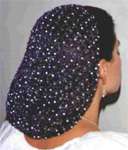Shpitzel
A shpitzel is a head covering worn by some married Hasidic women. It is a partial wig that only has hair in the front, the rest typically covered by a small pillbox hat or a headscarf.[1] The hairpiece may actually be silk or lace,[2] or else made of synthetic fibers, to avoid too closely resembling real hair.

According to Jewish law (halacha) concerning modesty (tzniut), a woman must cover her hair after marriage.[3][4] The shpitzel was popular among Hungarian Hasidim in the 19th century, and it is worn by some contemporary women who follow the customs of that community.
Etymology
The Yiddish word "Shpitzel" is related to the grammatical diminutive of the high-German word "Spitze" which can either mean "point" or "lace"; the latter translation is most likely the right one in the context of this article. (It must not be confused with the high-German "Spitzel" which is a spy or a snitch.)
The term shpitzel may also be used to refer to the ends of a loaf of bread in some dialects.[5] In this case, the above-mentioned translation "Spitze" = (end)point/peak is applicable, with its High German grammatical diminutive "Spitzchen".
Footnotes
| Wikimedia Commons has media related to Jewish headgear. |
- Hella Winston (15 November 2006). Unchosen: The Hidden Lives of Hasidic Rebels. Beacon Press. pp. 21, 181. ISBN 978-0-8070-3627-3. Retrieved 13 January 2013.
- Elbinger, Naomi. "The Tichel: A Short History of Headcovering Fashion". Retrieved January 13, 2013.
- Shulchan Aruch, Even Ha'ezer 115, 4; Orach Chayim 75,2; Even Ha'ezer 21, 2
- Schiller, Mayer. "The Obligation of Married Women to Cover Their Hair". JHCS 30, 1995, 81–108.
- Vaux, Bert. "Dialect Survey: What do you call the end of a loaf of bread?". Retrieved January 13, 2013.